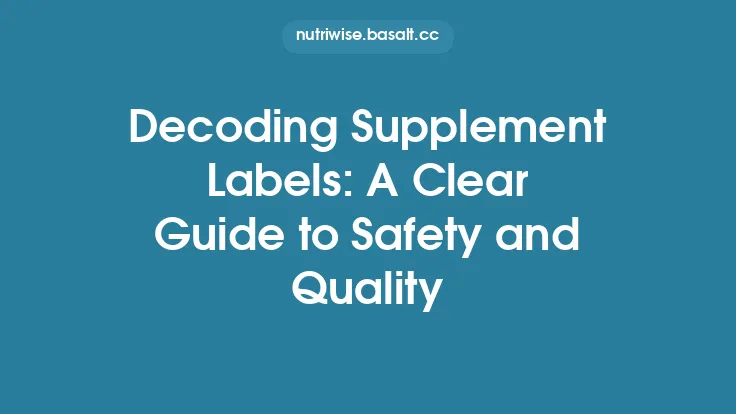Probiotic supplements have become a staple on many pharmacy shelves, but the numbers printed on the label can feel like a secret code. The most common figure you’ll see is the colony‑forming unit count, or CFU, which purports to quantify the “potency” of the product. Understanding what that number really means, how it is measured, and what factors can alter it over time is essential for anyone who wants to make an informed purchase and get the most out of a probiotic regimen.
What Exactly Is a CFU?
A colony‑forming unit (CFU) is a microbiological term that represents a single viable microorganism capable of replicating to form a visible colony on a nutrient agar plate under laboratory conditions. In practice, a CFU is used as a proxy for the number of living cells that can potentially colonize the gut after ingestion. Because many probiotic strains are difficult to count directly—some are non‑culturable under standard conditions—CFU remains the industry‑standard metric for labeling potency.
Key points to remember:
- Viable, not total – CFU counts only include cells that are alive and able to reproduce, not dead cells or cellular fragments.
- Culture‑dependent – The count depends on the specific growth medium and incubation conditions used in the laboratory; different labs may report slightly different numbers for the same sample.
- Logarithmic scale – CFU values are often expressed in powers of ten (e.g., 1 × 10⁹ CFU = 1 billion CFU). Small changes in the exponent represent large changes in absolute cell numbers.
How CFU Numbers Are Determined
The most common method for determining CFU is the plate count assay:
- Serial Dilution – A probiotic sample is diluted stepwise in a sterile buffer to achieve a concentration that will yield countable colonies (typically 30–300 colonies per plate).
- Plating – A measured volume of each dilution is spread onto agar plates that contain nutrients tailored to the specific strain(s).
- Incubation – Plates are incubated at a temperature and atmosphere optimal for the organism (often 35–37 °C, anaerobic for many gut strains) for 24–72 hours.
- Counting – Colonies are counted, and the original concentration is back‑calculated using the dilution factor.
More advanced or complementary techniques include:
- Flow Cytometry – Stains live cells with fluorescent dyes and counts them directly, providing rapid results but requiring calibration against plate counts.
- Quantitative PCR (qPCR) – Detects DNA copies of specific strains; when combined with viability dyes (e.g., propidium monoazide), it can approximate live cell numbers.
- Automated Imaging Systems – Capture high‑resolution images of plates and use software to count colonies, reducing human error.
Regardless of the method, reputable manufacturers will validate their assay against a standard plate count to ensure the CFU label reflects viable cells.
Decoding the Label: “CFU per Serving” vs. “CFU per Capsule”
Probiotic labels can present CFU information in several ways, and each format has implications for dosing:
| Label Format | What It Means | Practical Implication |
|---|---|---|
| 10 billion CFU per capsule | Each individual capsule contains at least 10 × 10⁹ viable cells at the time of manufacture (or at expiration, depending on the claim). | If you take one capsule daily, you receive 10 billion CFU per day. |
| 5 billion CFU per serving (2 capsules) | The recommended serving size is two capsules, together delivering 5 × 10⁹ CFU. | One capsule alone would provide only 2.5 billion CFU, which may be below the therapeutic threshold for some indications. |
| 30 billion CFU per day (30‑day supply) | The total CFU in the entire bottle is 30 × 10⁹, but the label does not specify per‑dose potency. | You must calculate the per‑dose amount based on the number of capsules in the bottle (e.g., 30 billion CFU ÷ 30 capsules = 1 billion CFU per capsule). |
| CFU guaranteed until expiration | The manufacturer commits that the product will retain the stated CFU count up to the printed expiration date, assuming proper storage. | This is more reliable than “CFU at time of manufacture,” which may have already declined before you open the bottle. |
When comparing products, always align the per‑dose CFU rather than the total CFU in the container. A 60‑capsule bottle with 5 billion CFU per capsule delivers a higher daily dose than a 30‑capsule bottle with 10 billion CFU total but only 0.33 billion CFU per capsule.
Minimum vs. Guaranteed CFU: What the Fine Print Means
Two common phrasing conventions appear on probiotic labels:
- “Minimum CFU” – Indicates the lowest number of viable cells you can expect per serving at the time of manufacture. The actual count may be higher, but manufacturers are not obligated to guarantee that the count will stay at that level throughout the product’s shelf life.
- “CFU guaranteed until expiration” – A stronger claim that the product will retain at least the stated CFU count up to the expiration date, provided storage instructions are followed. This guarantee typically requires third‑party stability testing.
Why the distinction matters:
- Stability Assurance – A “guaranteed until expiration” label gives you confidence that the probiotic will still be potent when you finish the bottle, even if you start using it months after purchase.
- Risk of Degradation – Probiotic cells are sensitive to heat, moisture, and oxygen. A product that only lists a minimum CFU at manufacture may have already lost a substantial fraction of its potency by the time it reaches the consumer.
If a label does not specify which claim is being made, you can request clarification from the manufacturer or look for third‑party certifications (e.g., USP Verified, NSF Certified for Sport) that often require a guaranteed CFU claim.
Factors That Influence CFU Viability Over Time
Even with a “guaranteed until expiration” claim, several variables can affect how many live cells remain at the point of consumption:
| Factor | Mechanism of Impact | Mitigation Strategies |
|---|---|---|
| Temperature | Heat accelerates cell death; many strains lose 1–2 log CFU per month at 25 °C, and even more at 30 °C. | Store in a cool, dry place; consider refrigerated products if ambient temperatures are high. |
| Moisture | Water activity promotes hydrolytic damage and encourages microbial contamination. | Keep the container tightly sealed; avoid storing in humid environments (e.g., bathrooms). |
| Oxygen Exposure | Aerobic conditions can oxidize cell membranes, especially for obligate anaerobes. | Look for products packaged in nitrogen‑flushed or blister‑packed containers. |
| Light | UV radiation can damage DNA and membrane lipids. | Choose opaque or amber‑colored bottles. |
| Formulation Matrix | The carrier (e.g., maltodextrin, inulin) can protect cells via lyophilization or act as a desiccant. | Prefer lyophilized (freeze‑dried) powders or capsules with protective excipients. |
| Enteric Coating | Coatings designed to survive stomach acid can also act as a barrier to moisture and oxygen. | Verify that the coating is intact; avoid crushing coated capsules. |
Manufacturers often conduct accelerated stability testing (e.g., storing at 40 °C for six months) to model how CFU counts decline under worst‑case conditions. The resulting data inform the expiration date and the “guaranteed CFU” claim.
Interpreting CFU Dosage in Light of Clinical Research
The therapeutic efficacy of a probiotic is not solely a function of the CFU number; it also depends on the strain, the health condition being targeted, and the duration of use. However, many clinical trials provide a useful reference range for CFU dosing:
- General gut health & occasional bloating – 1 – 10 billion CFU per day is often sufficient.
- Antibiotic‑associated diarrhea prevention – 5 – 10 billion CFU per day, administered during and for a week after antibiotic therapy.
- Irritable bowel syndrome (IBS) symptom relief – 10 – 30 billion CFU per day, typically for at least 8 weeks.
- Immune modulation (e.g., reducing upper‑respiratory infections) – 10 – 50 billion CFU per day, depending on the strain.
- Specific therapeutic indications (e.g., ulcerative colitis, atopic dermatitis) – Some studies use 20 – 100 billion CFU per day, often in divided doses.
These ranges are not universal; they are derived from trials that used particular strains under controlled conditions. When a label lists a CFU count that falls well below the range used in the relevant research, the product may still be beneficial for general maintenance but is unlikely to reproduce the same clinical outcomes.
Practical Tips for Comparing Probiotic Products
- Align the Dose with the Intended Use – If you are seeking a therapeutic effect that research supports at 20 billion CFU per day, a product offering 5 billion CFU per serving is unlikely to meet that goal, regardless of brand reputation.
- Check the “CFU at Expiration” Claim – Products that guarantee potency through the expiration date give you a more reliable estimate of the dose you will actually receive.
- Look for Strain Transparency – Even though the article avoids deep strain discussion, a label that lists the exact species and strain (e.g., Lactobacillus rhamnosus GG) allows you to cross‑reference the CFU dose with published studies.
- Consider the Delivery System – Enteric‑coated capsules, microencapsulation, and lyophilized powders can improve survivability through the stomach, effectively increasing the number of cells that reach the intestines.
- Verify Third‑Party Testing – Certifications from USP, NSF, or ConsumerLab often include independent verification of CFU counts and stability data.
- Factor in the Number of Servings per Container – A high total CFU count can be misleading if the product requires multiple servings per day to achieve the advertised per‑dose potency.
Common Pitfalls and Misconceptions About CFU Labels
- “Higher CFU = Better” – More isn’t always better. Extremely high doses can cause transient gas or bloating, and for many health goals, a modest dose is sufficient.
- “All CFU Are Equal” – Viability is strain‑specific; some strains are naturally more robust, while others are more sensitive to processing and storage.
- “CFU Remain Constant After Opening” – Once the container is opened, exposure to air and humidity accelerates cell loss. Use the product within the recommended period after opening (often 1–3 months).
- “CFU Count Includes Prebiotics” – Prebiotic fibers are sometimes listed alongside CFU numbers, but they do not contribute to the viable cell count.
- “CFU Guarantees Colonization” – A high CFU dose increases the probability that enough cells survive transit, but colonization also depends on host factors (e.g., existing microbiota, diet, gut pH).
Emerging Technologies That May Change How CFU Is Reported
The probiotic industry is experimenting with novel preservation and delivery methods that could shift the focus away from raw CFU numbers:
- Microencapsulation – Tiny polymeric beads protect cells from oxygen and acid, potentially allowing lower CFU doses to achieve the same intestinal delivery.
- Spore‑forming Probiotics – Certain Bacillus strains form durable spores that are counted differently (often as “spores per dose”) but can germinate in the gut.
- Synthetic Biology Platforms – Engineered strains may be designed to express therapeutic molecules at lower cell densities, reducing the need for high CFU counts.
- Digital Shelf‑Life Monitoring – RFID tags that track temperature exposure could provide real‑time estimates of remaining viable CFU, moving beyond static expiration dates.
While these innovations are still emerging, they underscore the importance of understanding the current CFU labeling conventions as a baseline for evaluating future products.
Bottom Line: Making Sense of the Numbers
- Identify the per‑dose CFU (not just the total in the bottle) and confirm whether the label guarantees that count through the expiration date.
- Match the dose to the evidence for your specific health goal; a dose far below the range used in clinical trials is unlikely to deliver the same benefits.
- Consider stability factors—temperature, moisture, oxygen, and packaging—all of which can erode CFU potency over time.
- Seek transparency—look for strain identification, third‑party testing, and clear statements about how the CFU count was determined.
- Don’t be swayed solely by magnitude; a well‑formulated 5 billion CFU product with proven stability may be more effective than a 50 billion CFU product that loses half its potency within weeks.
By decoding the CFU count and the surrounding label information, you can choose probiotic supplements that truly align with your health objectives, rather than relying on a single, potentially misleading number. Armed with this knowledge, the “code” on the bottle becomes a clear guide rather than an enigma.





